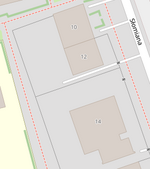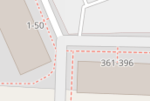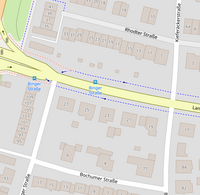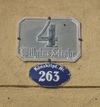Key:addr:*
| Description |
|---|
| A prefix for several addr:* keys to describe addresses. |
| Group: addresses |
| Used on these elements |
| See also |
| Status: de facto |
| taginfo: addr:* |
The various addr:*=* keys are used to provide address information for buildings and facilities. See Addresses for more details on usage.
How to map
Where to add the address
The address tagging should be added to
- the object



 of a point of interest;
of a point of interest; - the polygon representing an area
 (building or campus/site outline) if the address is valid for the whole object (e.g. a detached house, an individual terraced house, a school campus);
(building or campus/site outline) if the address is valid for the whole object (e.g. a detached house, an individual terraced house, a school campus); - to a particular node
 sitting on the site outline or building outline (e.g. entrance, gate) or contained within the object if the address applies to this point, in particular when an object has multiple addresses such as an apartment building with several entrances;
sitting on the site outline or building outline (e.g. entrance, gate) or contained within the object if the address applies to this point, in particular when an object has multiple addresses such as an apartment building with several entrances; - to a node
 if you are unsure about the extent of the address.
if you are unsure about the extent of the address.
For objects which do not have an official address, such as a lamppost or public artwork, a nearby address can be specified with object:*=* instead.
What to add
As a minimum, please add
- addr:housenumber=* (or addr:housename=* when this is part of the postal address)
- addr:street=*
If you know them and if they exist, please add:
- addr:city=* (adding to single elements might depend on local mapping practices)
- addr:postcode=* (adding to single elements might depend on local mapping practices)
- addr:country=* (depending on the mapping practices in your country)
If they are part of the postal address, please add:
- addr:suburb=*
- addr:state=*
- addr:province=*
- addr:floor=*
Example addresses rendered on map in OSM Carto style:
Higher-level tags such as addr:city=* and addr:postcode=* are often redundant, since they could be calculated from the respective boundary relations they are contained in (if present and valid).
The focus on the usage of addr:country=* differs across national communities, some consider it as necessary part of tagging (Germany), some as unwanted tag (Poland).
Collection methods
- Rapid Address Collection describes methods of collecting addresses rapidly.
Commonly used subkeys
| Key | Value | Element | Comment | Rendering | Photo | |
|---|---|---|---|---|---|---|
Tags for individual houses | ||||||
| addr:housenumber | user defined | The house number (may contain letters, dashes or other characters). Addresses describes ways to tag a single building with multiple addresses. Please do not only tag addr:housenumber=*, but also add at least addr:street=* or addr:place=* for places without streets (or map the belonging to a street with a relation using associatedStreet relation or street relation.) |

|
|||
| addr:housename | user defined | The name of a house. This is sometimes used in some countries like England, Spain, Portugal, Latvia instead of (or in addition to) a house number. |
||||
| addr:flats | user defined | The unit numbers (a range or a list) of the flats or apartments located behind a single entrance door. | 
|

| ||
| addr:conscriptionnumber | user defined | This special kind of housenumber relates to a settlement instead of a street. Conscription numbers were introduced in the Austro-Hungarian Empire and are still in use in some parts of Europe, sometimes together with street-related housenumbers which are also called orientation numbers. | ||||
| addr:street | user defined | The name of the respective street. If the street name is very long or nonexistent, the ref of the respective street. A way with highway=* or a square with place=square and the corresponding name should be found nearby. The belonging to a street can alternatively be represented by a associatedStreet relation or street relation. The keys addr:housenumber=* and addr:street=* in principle are the only necessary ones if there are valid border polygons. If you are not sure if it is so, just add addr:city=*, addr:postcode=* and addr:country=*. |
||||
| addr:place | user defined | This is part of an address which refers to the name of some territorial zone (usually a place=* like island, square or very small village) instead of a street (highway=*). Should not be used together with addr:street=*. | ||||
| addr:postcode | user defined | The postal code of the building/area. Some mappers prefer to rely on boundary=postal_code | ||||
| addr:city | user defined | The name of the city as given in postal addresses of the building/area. (In some places the city in the address corresponds to the post office that serves the area rather than the actual city, if any, in which the building is located.) Some mappers assume it can be derived from a boundary=administrative relation. | ||||
| addr:country | user defined | The ISO 3166-1 alpha-2 two letter country code in upper case. Example: "DE" for Germany, "CH" for Switzerland, "AT" for Austria, "FR" for France, "IT" for Italy. Caveat: The ISO 3166-1 code for Great Britain is "GB" and not "UK". More or less favoured in different national communities. |
||||
| addr:postbox | user defined | Use this for addressing postal service Post Office Box (PO Box, BP - Boîte Postale, CP - Case Postale, Поштански преградак, Поштански фах, Поштански претинац) as alternative to addressing using street names. Example: "PO Box 34" | ||||
| addr:full | user defined | Use this for a full-text, often multi-line, address if you find the structured address fields unsuitable for denoting the address of this particular location. Examples: "Fifth house on the left after the village oak, Smalltown, Smallcountry", or addresses using special delivery names or codes (possibly via an unrelated city name and post code), or PO Boxes. Beware that these strings can hardly be parsed by software: "1200 West Sunset Boulevard Suite 110A" is still better represented as addr:housenumber=1200 + addr:street=West Sunset Boulevard + addr:unit=110A. |
||||
For countries using hamlet, subdistrict, district, province, state, county | ||||||
| addr:hamlet | user defined | The hamlet of the object. In France, some addresses use hamlets instead of street names, use the generic addr:place instead. | ||||
| addr:suburb | user defined | If an address exists several times in a city. You have to add the name of the settlement. See Australian definition of suburb. | ||||
| addr:subdistrict | user defined | The subdistrict of the object. | ||||
| addr:district | user defined | The district of the object. | ||||
| addr:province | user defined | The province of the object. For Canada, uppercase two-letter postal abbreviations (BC, AB, ON, QC, etc.) are used. In Russia a synonym {{{key:addr:region}}} is widely used | ||||
| addr:state | user defined | The state of the object. For the US, uppercase two-letter postal abbreviations (AK, CA, HI, NY, TX, WY, etc.) are used. | ||||
| addr:county | user defined | The county of the object. | ||||
Tags for interpolation ways | ||||||
| addr:interpolation | all/even/odd/ alphabetic | How to interpolate the house numbers belonging to the way along the respective street. See detailed description. |
||||
| addr:interpolation | Number n | Every nth house between the end nodes is represented by the interpolation way. | ||||
| addr:inclusion | actual/estimate/potential | Optional tag to indicate the accuracy level of survey used to create the address interpolation way. See detailed description. |
||||
Detailed subkeys
More detailed information as approved here: Proposed features/addr keys (2011-04)
| Key | Value | Element | Comment | Photo | Taginfo |
|---|---|---|---|---|---|
| Tags for parts of a building | |||||
| addr:door | user defined | The door number (or name) of an apartment/flat/office/room. Could also be called differently in some countries (In Austria for example it is sometimes referred to as "Top"). If a room has more than one door, you can tag them separately.
See also: room=* |
|||
| addr:unit | user defined | The number, letter, or name of a single unit or flat that exists within a larger complex. While a big building could have only one entrance, sometimes the way inside divides into different units or staircases, where certain apartments/flats/offices can only be reached through a specific unit. Useful for apartment, suite, or office numbers. Information necessary for postmen, for example.
In the United States, there is no consensus on how to represent secondary unit designators, however according to taginfo it is far more popular to omit the designator and only include the identifier: there are only a few thousand "Apartment/Unit/Suite A" entries versus 46,000 "A" entries as of 2021. This practice only allows data consumers to format the unit as "#A", which the USPS says will result in rejected mail in some cases. [1] Consider using addr:full=* to disambiguate. |
|||
| addr:flats | user defined | A list of flat numbers accessible in a building or behind a door. | |||
| addr:floor | Number | The floor number that is part of the address of an apartment/flat/office. Also add level=*, which is applicable regardless of whether the floor number is part of the address. | |||
| addr:block | user defined | The city block, if part of the address. Note that this tag is most often used in places where blocks can have names and not just numbers, and in many cases is specified in addition to a street name. This tag is common in a variety of countries, including India, Egypt, and Kuwait. addr:block_number=* on the other hand is common in Japan, where blocks are typically numbered and often are specified instead of a street name. | |||
| addr:block_number | user defined | The city block, if part of the address. This version of the tag is used in Japan, where it is common for house numbers to be associated with blocks where a street does not have a name. These blocks are typically numbered, hence the name. See JA:住所 § 街区 Block number address systemについて. addr:block=* is semantically different in that it may describe blocks that have names rather than numbers, and is not as commonly used in Japan. | |||
| addr:plot | user defined | Undocumented tag to specify the plot number in an address which includes one. | |||
Multilingual addresses
In areas with two or more official languages, addresses can be localized by adding a language code after the usual address keys like:
How language codes are selected is described in multilingual names.
Addresses without house numbers
- If there wasn’t a house number assigned to the address, you can use nohousenumber=yes
Old (former) house numbers and street names
Sometimes house numbers or street names change. In this event, it may still be useful to keep track of the former address (e.g. because it is still visible, because it makes house numbers unambiguous with respect to the old/new question, etc.). The common tag for these is old_addr:housenumber=* and old_addr:street=*. Similarly, for areas with house numbers referring to a place rather than a street, old_addr:place=* is used.
Possible tagging mistakes
See also
- addr:streetnumber=* — Secondary house numbers known as "číslo orientační" in the Czech Republic.
- addr:street:corner=* — Names of an address's corner street, often used in the Philippines.
- contact:*=* — The contact tag is the prefix for several contact:* keys to describe contacts.
- Proposal Proposed features/House numbers/Bremen Schema uses contact:*=* to avoid addresses duplication.
- 2008 Proposal Proposed features/House numbers/Karlsruhe Schema
- 2011 Proposal Proposed features/addr keys (2011-04)
- 2011 Proposal Proposed features/addr:place
- 2019/10 Proposal Proposed features/Addr:milestone for distance based addresses
- 2022 under active discussion on Talk GB is Addresses in the United Kingdom — tags on this page are part of this discussion.








